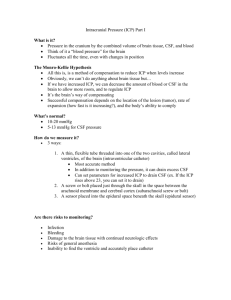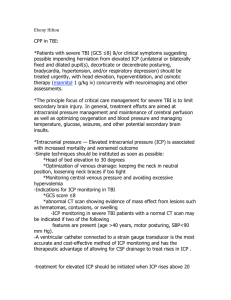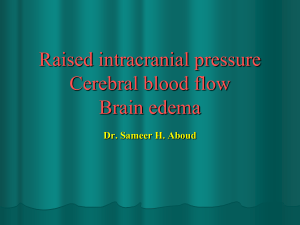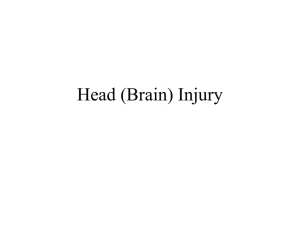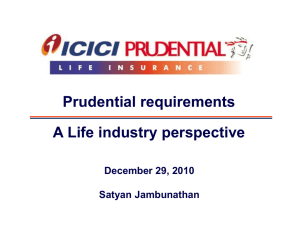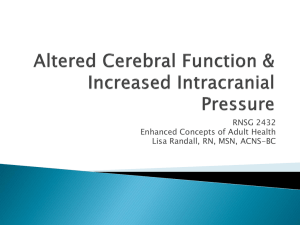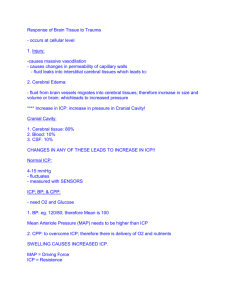ICP
advertisement
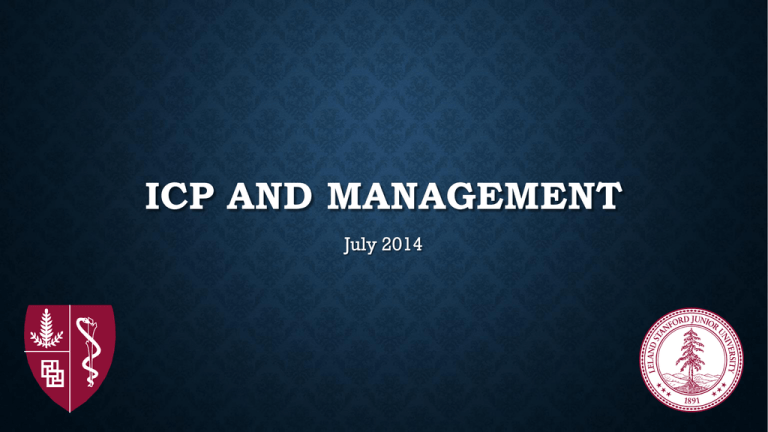
ICP AND MANAGEMENT July 2014 OUTLINE • Intracranial contents • Monroe-Kellie Doctrine • ICP monitors and waveforms • Calculate cerebral perfusion pressure • Types of edema and Herniation Syndromes • Management of ICP VAULT CONTENTS Blood 10% Other 1% CSF 10% Brain 79% MONROE-KELLIE DOCTRINE • An increase in the volume of any of the contents within the intracranial vault must be met with a decrease in the volume of another or the intracranial pressure will increase • V (vault)= V (CSF) + V (brain) + V (blood) + V (other) INTRINSIC COMPENSATORY MECHANISMS • Brain- none • CSF- redistributed into compliant paraspinal CSF space • Blood- venous blood forced into internal jugular veins • When compensatory mechanisms are exhausted, ICP rises more rapidly CBF VIA AUTO-REGULATION Maximally Dilated Ischemia Ischemia, disrupted BBB, inc ICP • Maintains CBF via auto-regulation over wide range of MAP by altering resistance of cerebral blood vessels • This insures supply of oxygen and metabolic substrates to neurons are unaltered • ICP > 20 has been shown in both adult and pediatric studies to be associated with increased morbidity and mortality LOSS OF AUTO-REGULATION • CPP = MAP – ICP • Minimal CPP is age variant • Infants 50 mmHg • Children 60 mmHg • Adults 70 mmHg MAINTAINING ADEQUATE BRAIN OXYGENATION • Hypoxia results in vasodilation therefore increasing CBF and potentially worsening ICP • Another way of maintaining good oxygenation is to attack it from the consumptive end • Decrease cerebral metabolism • Keep patient adequately sedated • In extreme cases, use a pentobarbital induced coma ETIOLOGIES OF ELEVATED ICP • Increased ICP can occur with any CNS pathology that results in a space • occupying mass lesion, edema (osmotic, vasogenic, cytotoxic), or obstruction to • CSF flow. Some common etiologies include: • • Trauma: epidural, subdural bleeds, contusion, hematomas, diffuse axonal • injury, intraventricular hemorrhage • • Infection: meningitis, encephalitis, cerebritis • • VP shunt malfunction • • Mass lesion: tumors, AVM • • Metabolic: hepatic encephalopathy, DKA • • Vascular or embolic disease, stroke with subsequent edema or mass effect ICP MONITORS AND WAVEFORMS • • Intraventricular monitoring • advantage of accuracy, simplicity of measurement, and the unique characteristic of drainage of CSF. • disadvantage is infection, up to 20 percent of patients, hemorrhage Intraparenchymal (thin electronic or fiberoptic transducer) • Advantages include ease of placement, and a lower risk of infection and hemorrhage (<1 percent) than with intraventricular devices • Disadvantages include the inability to drain CSF for diagnostic or therapeutic purposes and the potential to lose accuracy (or "drift") over several days, since the transducer cannot be recalibrated following initial placement WAYS TO DECREASE ICP • Size of the box • May increase size of vault with decompressive crainectomy • Decrease the volume of the contents • Remove “others”- tumors, crowbars, hematomas, bullets, etc. • Must decrease volume of one of the components of the intracranial vault • Brain • CSF • Blood TYPES OF EDEMA Vasogenic Interstitial Cytotoxic Increased permeability of brain capillary endothelium leads to edema and is usually seen around tumors, abscesses, intracerebral hematomas, encephalitis & meningitis. Edema results from increased CSF hydrostatic pressure and is usually seen in hydrocephalus or decreased CSF absorption by arachnoid villi, e.g. intraventricular hemorrhage. Neuronal swelling occurs secondary to cell injury caused by failure of the ATPase – dependent pump as occurs in diffuse axonal injury. Neurons are not primarily injured. Reduction of this type of edema can minimize secondary injury This type of injury is often irreversible. 5 WAYS TO DECREASE INTRACRANIAL PRESSURE USING THE MONRO-KELLIE DOCTRINE • Enhance venous drainage • Elevate head 30° • If in a cervical collar, check fit • Hyperosmolar therapy • Hyperventilation • CSF Drainage • Decompression DECOMPRESSIVE CRANIECTOMY • Done infrequently • Usually done at an OSH prior to transfer OR in conjunction with hematoma evacuation • Remember to save the bone flap for reimplantation later CSF DRAINAGE • Neurosurgical Procedure • Always push for an EVD, not just an ICP monitor • Therapeutic AND diagnostic • Can stay in long-term (no drift) • Requires INR < 1.5 and PLTS > 100K HYPEROSMOLAR THERAPY • Increase serum osmolality to draw water out of brain parenchyma • Mannitol • Decreases bld viscosity • 0.5 - 1g/kg • Maximal effect in 10 min, duration 75 min • 3% Saline (500 mEq/L) • Osmotic, hemodynamic, vasoregulatory, and immunodmodulatory • Every 1.5 cc/kg will increase Na by ≈ 1 mEq/L • Known to have a longer lasting effect • In general, check Na+ and osmolality q6h • Target Na2+ 150-160 • Target osmolality > 300 HYPERVENTILATION CAUSES A DECREASE IN CEREBRAL BLOOD FLOW • Pic of blood flow with hypervent • Skippen. Crit Care Med. 1997 Aug;25(8):1402-9 USE OF HYPERVENTILATION • Worse long-term outcome • Target normocapnea • Works for acute spikes in ICP • Target pCO2 of about 35 • Avoid hypercapnea AVOID THE BAD “H”S • Hypotension • Hypoxia • Hyponatremia • Hypervolemia • Hyperglycemia • Hyperthermia • Hypermetabolism (seizures, agitation) SUMMARY OF KEY POINTS • Many of the goals of increased ICP management are based using the Monro-Kellie Doctrine to our advantage • Goal ICP < 20 mmHg • Hyperventilation is not a long-term strategy • CPP = MAP – ICP; Maintain CPP > 40 mmHg • Goal Na2+ 150-160 • Avoid the bad “H’s”

